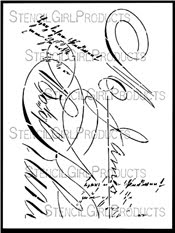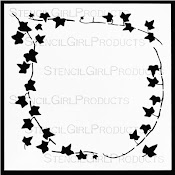(1.) They can be camouflaged:
 |
| Above: I sprayed acrylic inks over the entire print to camouflage the run-under areas. |
Another example:
 |
| Above: This print made from the stencil Osprey Wings had under-runs along the edges. |
 |
| Above: This is the same image after I sprayed it with acrylic inks. |
 |
| Above: the Pat Dews mouth atomizer and acrylic inks that I use with it to create sprays. Another option would be to use Color Bloom Sprays or Ranger's Color Wash sprays. |
(2.) Run-unders can also be painted out:
 |
Above: my 6"X6" Gingko stencil was used to make this greeting card cover; I had two areas of run-under, which I later touched up with a small paintbrush dipped into the pearlescent paint.
|
More examples showing alcohol inks on pearlescent paper:
 |
| Above: my 6"X6" stencil Ferns was used to create this greeting card cover. |
 |
| Above: my 6"X6" stencil Flowers Version 1 was used to create this greeting card cover. |
 |
| Above: My 9"X12" stencil Ivy Frame was used to create this greeting card cover. |
All the above stencils, and many more, are available here at STENCILGIRL(TM)Products:




























































































